For several years we have witnessed the popularization of many fields: natural sciences, history, and even news. In addition to selling, it is sometimes a matter of making shortcuts suggesting that the subject is mastered. At SecondFlor, we decided to take the opposite view. We prefer to initiate the movement of knowledge so that no one is fooled, and the consumer can be 100% aware of what he is buying. That is why we work hard to set up and impose a semantic field in the preserved plants world.
Disclaimer
In order to clarify all the techniques that exist and to give the right information on the product we sell, we are creating a semantics that did not exist. Too often, the term “preserved” is misused to characterize plants that are not preserved. It is for example difficult to admit that we can compare moss ball simply sprayed with a papyrus stabilized by capillarity. It is neither the same technology, nor the same reliability, nor the same finished product. This semantic question is a worldwide matter, in all languages. However, in English, “preserved” is a term that is used for preserved and stabilized plants.
The various techniques used on plants
Preserved or stabilized?
Preservation is a technique to preserve plants starting from dry raw material. We say “preserved” in English, “préservé” in French, “preservado” in Spanish, “konserviert” in deutsch, “conservato” in italian, etc.
You will find preserved by immersion or spraying preservation.
Stabilization, on the other hand, consists of a technology for preserving a fresh plant. It’s a much more advanced technique. The word “stabilized” exists, was well incorporated in several languages except for English where we use “preserved” for plants.
You will find capillarity stabilization (mainly used on foliage), and the double immersion technique.
The others techniques used on plants
A lyophilized plant no longer has water thanks to the drying process implemented on a frozen plant. The water, in the ice state, evaporates without melting. This allows it to preserve both its volume and appearance. To read more about the freeze-dryong technique, click here.
A dried plant sees its water evaporate during the hot drying process. It then loses its softness and lustre.
Why is it important to use the right lexicon?
These techniques are not regulated. So we decided to structure the terms according to production techniques. This lexicon is also imposed on the SecondFlor site so that our customers can relate. It is essential to distinguish between dried, lyophilized, preserved and stabilized.
Professionals in this universe have tended to describe any plant as “stabilized”, taking advantage of their clients’ lack of knowledge. The consumer must be interested in the techniques in order to know what he is buying. Whether it is florists or their customers, it is important to know the specificities of each product in order to know what to expect. You are not only buying a plant, but also a preservation technique.
Focus on the hydrangea and its various possibilities
Take hydrangea, for example. It exists dried, tinted dried, preserved by immersion, stabilized by double immersion (with alcohol), stabilized by capillarity. The same plant has the capacity to be preserved according to all these techniques. Each of these methodologies has its pros and cons: maintaining flexibility, colour strength, colour reliability over time, price, etc. Without a thorough knowledge of the product, it is difficult for the consumer to find his way around and know the difference.
You, as professionals, be curious, and be demanding toward your suppliers on the quality of the words they choose. In any case, we have picked to serve you quality 😉.
You may also read : stabilization processes page on SecondFlor

